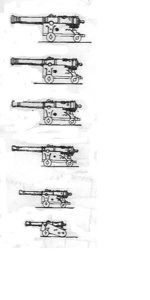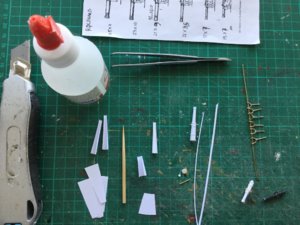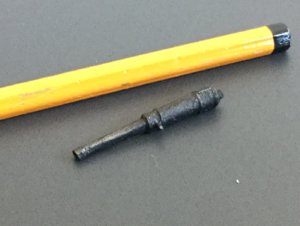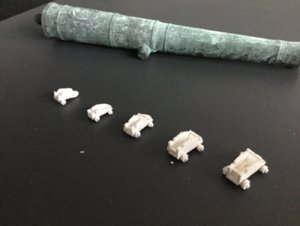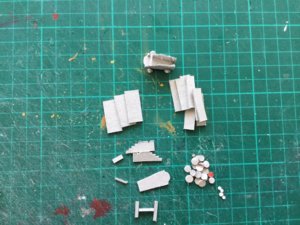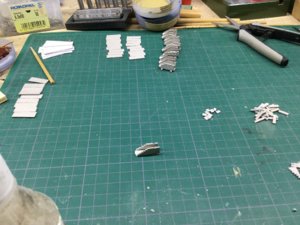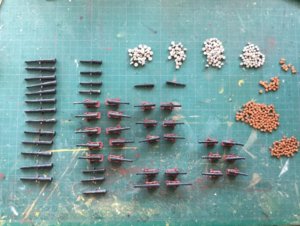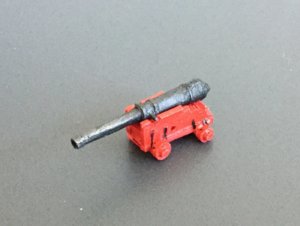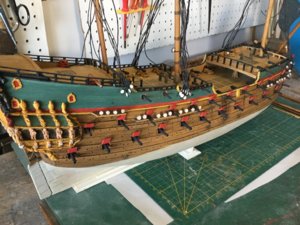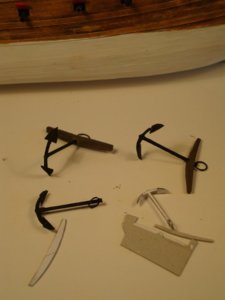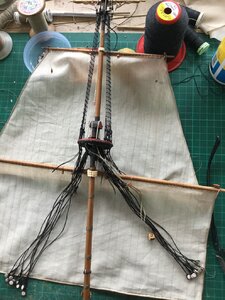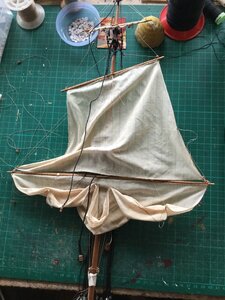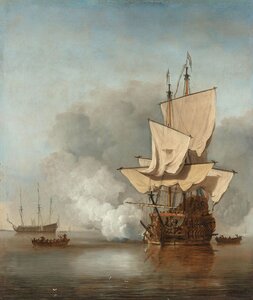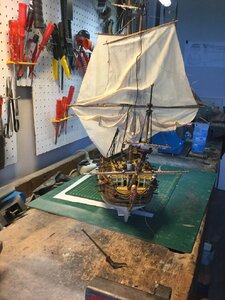Perhaps you are interested in witnessing one of my builds. My system is fast and cheap and it hardly makes a mess of the workshop. Consider it as 'modelbuilding light'.
It always starts with a draught. Many times, if there are no useful drawings available, I have to develop them from scratch, like for instance an original specification contract. My loyal Belgium friend Rene Hendrickx works my suggestions out in the free downloadable shipbuilding program Delftship, so I can print the lines and body plan.
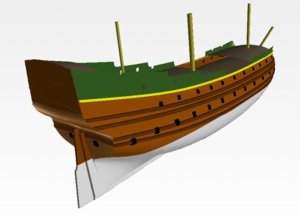
I glue the frame prints to stiff card and cut them out. I use a stuff called grey-board, available at your art-supplier, but any stiff card you have in your dustbin will do.
I double the frames below lower deck level and cut slots in them to fit the deck.
I'm not sure if these pictures come from this particular project, but since there is little difference they will do.
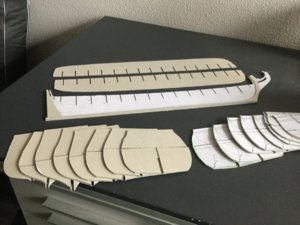
Then the whole contraption is glued together.

Then the lines of the ship are decided by placing the lower wale. This is a tricky part, as there are very few points that can be used as a reference. Small deviations will end up in a terrible mess, so care has to be taken.
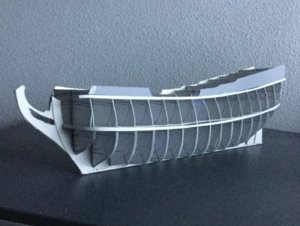 .
.
Then the frames are covered by strips of cardboard. I use a kind of soft and fluffy material, called 'wood board'. At the same time I removed the parts of the frames above deck level and doubled the inside with another layer of wood board.
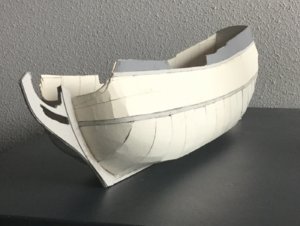
Then I use filler to get rid of the angles. The nice thing of wood board is that it can be sanded (up to a degree) without delaminating. I also cut the lower gunports.
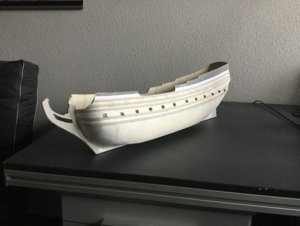
After dry-fitting the upper decks the upper gunports can be cut out. Don't bother to look at the pleasure vessel in the fore-ground, this is the first picture of the warship I made, showing it in a stage ready to be planked.
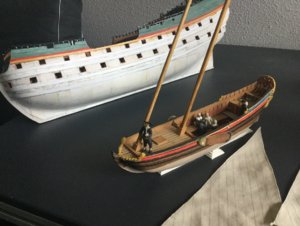
All this makes a very quick process. It only took a week to get to this stage. In fact I hardly noticed I was making this vessel, because I work on six or seven hulls at the same time and I completely forgot to take pictures of this one.
The whole hull below the upper wale is 'planked' with strips of wood imprinted, self adhesive white plastic, called c-d-plastic. Very cheap and it works easy, because with the use of a hair dryer they can be bend in the necessary curves.
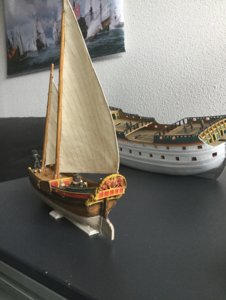
After a primer I paint the hull above the waterline with Humbrol 64 and below with 28.
After a week of drying I brush a dark brown, called Van Dijks Bruin (from a tube), over the upper part. Immediately after that I wipe the brown off with a soft cloth, leaving paint in the wood print, so a suggestion of real wood is achieved.
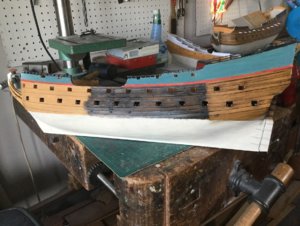
Now I can finish the details like the carvings and painting. I found a ship that matches the size of this model, called Akerboom (oak tree), with the right number of guns.
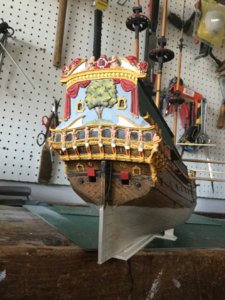
The rest is a simple rigging job.
I always prepare my masts up to the stage that they can be fitted with sails on them. That way I can work on them, without forcing myself too long in the same attitude, leaving me with sour arms and shoulders. Another thing that has to do with age is that I leave both my deadeyes and my ratlines white until they are ready and I can finish them with a dark paint.
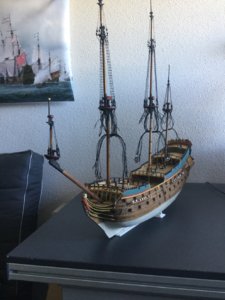
When I will work on the rigging again I will keep you posted. I don't know when that will be, because I am a bit inconstant nowadays. There are a lot of projects waiting for me.
It always starts with a draught. Many times, if there are no useful drawings available, I have to develop them from scratch, like for instance an original specification contract. My loyal Belgium friend Rene Hendrickx works my suggestions out in the free downloadable shipbuilding program Delftship, so I can print the lines and body plan.

I glue the frame prints to stiff card and cut them out. I use a stuff called grey-board, available at your art-supplier, but any stiff card you have in your dustbin will do.
I double the frames below lower deck level and cut slots in them to fit the deck.
I'm not sure if these pictures come from this particular project, but since there is little difference they will do.

Then the whole contraption is glued together.

Then the lines of the ship are decided by placing the lower wale. This is a tricky part, as there are very few points that can be used as a reference. Small deviations will end up in a terrible mess, so care has to be taken.
 .
.Then the frames are covered by strips of cardboard. I use a kind of soft and fluffy material, called 'wood board'. At the same time I removed the parts of the frames above deck level and doubled the inside with another layer of wood board.

Then I use filler to get rid of the angles. The nice thing of wood board is that it can be sanded (up to a degree) without delaminating. I also cut the lower gunports.

After dry-fitting the upper decks the upper gunports can be cut out. Don't bother to look at the pleasure vessel in the fore-ground, this is the first picture of the warship I made, showing it in a stage ready to be planked.

All this makes a very quick process. It only took a week to get to this stage. In fact I hardly noticed I was making this vessel, because I work on six or seven hulls at the same time and I completely forgot to take pictures of this one.
The whole hull below the upper wale is 'planked' with strips of wood imprinted, self adhesive white plastic, called c-d-plastic. Very cheap and it works easy, because with the use of a hair dryer they can be bend in the necessary curves.

After a primer I paint the hull above the waterline with Humbrol 64 and below with 28.
After a week of drying I brush a dark brown, called Van Dijks Bruin (from a tube), over the upper part. Immediately after that I wipe the brown off with a soft cloth, leaving paint in the wood print, so a suggestion of real wood is achieved.

Now I can finish the details like the carvings and painting. I found a ship that matches the size of this model, called Akerboom (oak tree), with the right number of guns.

The rest is a simple rigging job.
I always prepare my masts up to the stage that they can be fitted with sails on them. That way I can work on them, without forcing myself too long in the same attitude, leaving me with sour arms and shoulders. Another thing that has to do with age is that I leave both my deadeyes and my ratlines white until they are ready and I can finish them with a dark paint.

When I will work on the rigging again I will keep you posted. I don't know when that will be, because I am a bit inconstant nowadays. There are a lot of projects waiting for me.
Attachments
-
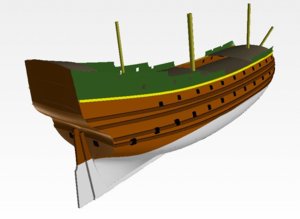 Fig. 16 Knipsel 2 kopie.JPG67.5 KB · Views: 27
Fig. 16 Knipsel 2 kopie.JPG67.5 KB · Views: 27 -
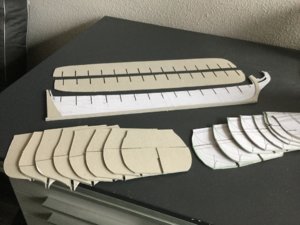 IMG_0105.jpeg273.9 KB · Views: 22
IMG_0105.jpeg273.9 KB · Views: 22 -
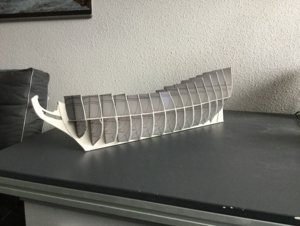 IMG_0100.jpeg244.8 KB · Views: 21
IMG_0100.jpeg244.8 KB · Views: 21 -
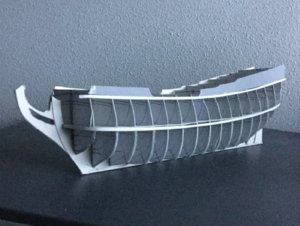 IMG_0107.jpeg275.3 KB · Views: 20
IMG_0107.jpeg275.3 KB · Views: 20 -
 IMG_0112.jpeg233.1 KB · Views: 20
IMG_0112.jpeg233.1 KB · Views: 20 -
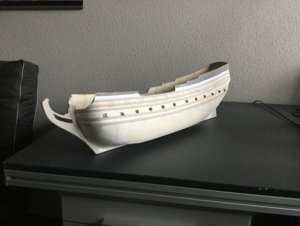 IMG_0119.jpeg220.9 KB · Views: 19
IMG_0119.jpeg220.9 KB · Views: 19 -
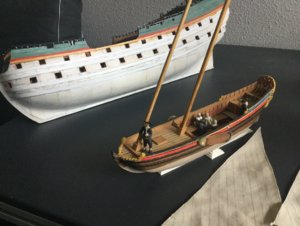 IMG_0394.jpeg269.2 KB · Views: 25
IMG_0394.jpeg269.2 KB · Views: 25 -
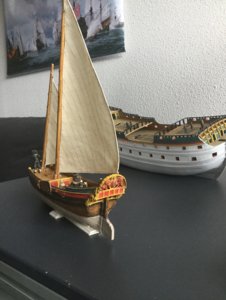 IMG_0692.jpeg274.3 KB · Views: 33
IMG_0692.jpeg274.3 KB · Views: 33 -
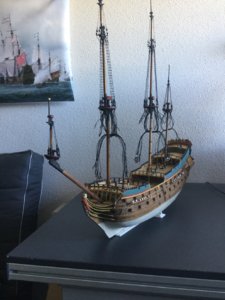 IMG_0802 kopie.jpeg551.8 KB · Views: 39
IMG_0802 kopie.jpeg551.8 KB · Views: 39






